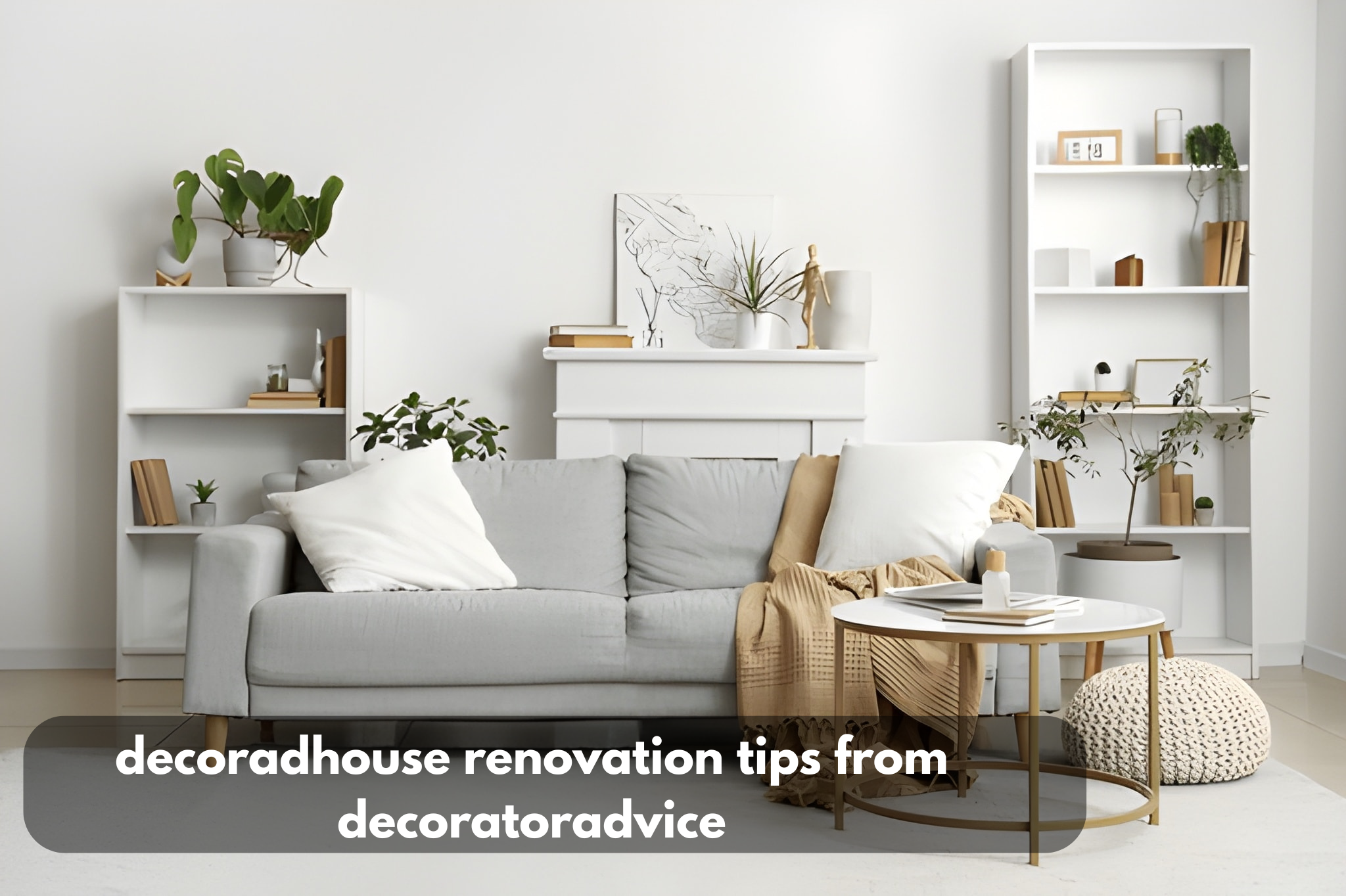10+ Expert decoradhouse renovation tips from decoratoradvice
Renovation can feel heavy and noisy. It can also change how you live. The right approach makes the difference. These decoradhouse renovation tips from decoratoradvice bring clarity. They focus on plan, people, and materials more than on trends. You will read practical steps for budgeting, hiring, timing, and choosing finishes. You will get guidance on kitchens and bathrooms that keep value. You will learn simple ways to reduce surprises and delays. This article pulls lessons from builders and designers and turns them into actions you can use in the United States. Read these decoradhouse renovation tips from decoratoradvice to set a clear plan and get work done without wasted time or money. Insights here draw on experience from decoratoradvice com and other leading sources.
Plan and set clear goals

Start with reasons. Make a decision on what you wish to alter and why. A goal might be to add light in the living room, make the kitchen more usable, or increase resale value. Write down priorities in plain language. Rank them with money and time in mind. When you are clear, trades can bid accurately. When you lack clarity, choices ripple through the project and raise costs.
Break the job into phases if needed. A phased plan lets you live in the house while you work. It also spreads cost. For each phase, name the outcome, the budget range, and a usable timeline. This keeps decisions small and practical.
Build a simple decision file. Keep product specs, photos, and contact names in one folder. This small habit cuts down on delays and arguments.
Make a contingency budget. Most experienced renovators set aside at least ten percent of the project cost for unexpected issues. For older homes, plan for more. Hidden plumbing, old wiring, and poor framing show up during demo. A contingency protects the timeline and keeps you from making poor tradeoffs in the middle of work. More planning resources appear on https//decoratoradvice.com if you want further examples.
Work With the Right Professionals
Hire someone who listens. Ask about past projects that match your scope. Ask for references and call them. A contractor or designer who explains tradeoffs and shows finished work is worth the time.
Check licenses and insurance. Confirm the contractor carries liability insurance and workers’ compensation. Without them, you take a bigger risk if a worker is hurt or if damage occurs.
Avoid the cheapest bid trap. The low offer often cuts corners by using cheaper materials or rushing work. Choose the greatest fit over the cheapest one. A fair bid with clear items and allowances gives you leverage. It also reduces change orders.
Get a written scope with milestones. The document should name who provides which materials, what allowances apply, and how payment will be staged. Holdbacks at key milestones help align incentive. For complex jobs hire a project manager or a designer who will coordinate trades and protect quality. These are some of the essential decoration tips decoradhouse from decoratoradvice you can apply.
Order Early and Manage Lead Times

Expect longer lead times now than in past years. Cabinets, appliances, and custom items often take weeks or months to arrive. Plan orders early and confirm delivery windows in writing. If you wait, you may stall the entire schedule.
Use reliable vendors. Pick cabinet suppliers and appliance dealers with strong delivery records. Ask about alternatives and backups. If a preferred item sells out, a backup choice avoids a stopgap. Keep a record of item numbers and expected arrival dates.
Factor in shipping and installation gaps. Delivery often arrives before installation teams are available. Hold a short buffer in the schedule for this. When possible, schedule installers after delivery windows rather than before. For a deeper look at planning and communication, you can check about decoratoradvice .com which covers more process insights.
Prepare a temporary living plan. A full kitchen renovation can leave you without a stove or sink for weeks. Set up a backup kitchen or plan meals around devices you can use. This saves stress and reduces impulse spending while the job is underway.
Prioritize Kitchens and Bathrooms for Value
Kitchens and bathrooms often return the most value when done well. They are highly visible to future buyers and matter to daily life. Invest in layouts that work. A small shift in layout can create much more usable space than cosmetic upgrades.
Focus on function first. Pick durable surfaces and smart storage. A deeper sink, better drawer organizers, and a thoughtful pantry often make more difference than premium cabinet fronts. Choose appliances that match your requirements instead of pursuing the priciest models.
Choose finishes with longevity in mind. Materials that handle wear are better long-term. For floors and counters, pick options that balance look and durability. Matte finishes can hide scratches and fingerprints better than glossy ones.
Think in systems, not in single pieces. Plumbing, ventilation, and lighting should be designed together so each supports the others. You can see some of the latest decoratoradvice .com ideas about functional kitchens, for example.
Choose Durable Systems and Finishes

Hidden systems matter more than finished details. New plumbing and updated electrical wiring reduce future problems. Upgrading HVAC or proper insulation lowers long-term energy usage and increases comfort.
Pick finishes that are repairable. Natural stone needs sealing and occasional repair. Engineered surfaces can offer easier upkeep. Choose paints with high hide and mildew resistance in damp areas. For trim, choose paint or stain that can be touched up without full replacement.
Plan for maintenance. Leave access panels where future servicing might be needed. Label shutoffs for water and circuits. These small choices save time and money for future owners and for you.
Include a reasonable warranty plan. Ask trades to provide written warranty terms for labor. For systems like HVAC and major appliances, keep manufacturer warranties and registration documents in your decision file. These steps protect you when problems occur after move in. You can also explore decoradtech smart home ideas by decoratoradvice to learn how technology can add control and reduce waste.
Smart Layout and Correct Scale
Scale controls comfort. A too large sofa overwhelms a modest room. A rug that is too tiny gives the room a disorganized air. Measure rooms and create simple mock ups with paper or tape before you buy. Walk the space with furniture templates to confirm circulation.
Open plans can work but consider sight lines. Keep storage near function. Place charging stations where family members need them. Plan appliance clearances so doors and drawers open without blocking walkways.
Think of movement through the house. Zoning can help. Use rugs and furniture placement to create separate areas within a larger space. Good zoning makes a home feel larger without structural work.
Lighting affects perceived scale. A well-lit room feels larger and more welcoming. Plan layered lighting with overhead, task, and accent sources. Choose fixtures that match room scale so pendants do not feel too big over narrow islands or too small over a long table. For partnership case studies, you can review decoratoradvice .com partners which shows how different trades collaborate.
Lighting and Color Choices That Last
Lighting and color shape mood more than most finishes. Pick a consistent white for trim and a palette that supports natural light. Test paint on large swatches in the room and observe them during morning and evening light.
Layer lighting. Use general illumination for even light, task lighting for counters and desks, and accent lighting for art and shelves. Dimmers add flexibility and help save energy when full light is not needed.
Match fixture size to ceiling height. Lower ceilings suit flush fixtures and mini pendants. Higher ceilings can handle larger statement pieces. Be mindful of the color temperature and type of bulb. Warm whites create a cozy feel. Cooler light reads as sharper and more task-oriented.
This reflects another core principle behind decoratoradvice .com home which emphasizes comfort and timeless design.
Small Space Solutions and Storage
Small homes need creative storage more than luxury finishes. With built-ins, a wall may serve as both a showcase and a storage space. Pocket doors save swing space for bathrooms and closets.
Make use of vertical space. Clear flooring and less clutter are maintained with tall cabinets and storage. Choose multifunction furniture. A bench with storage in an entry creates a tidy landing. A bed with drawers or a platform with hidden storage keeps bedrooms neat.
Work room by room and find the high-impact spots for added storage. Often the areas near entries, kitchens, and bathrooms benefit most. When you add storage, do it where it supports daily habits so the new space actually gets used.
Sustainability and Future Proofing
Cut energy waste before you pick new finishes. Seal cracks around doors and windows. Add insulation where the house leaks heat or cool air. Simple steps like these make a home cheaper to run and more comfortable every season.
Pick materials you won’t have to replace every few years. Siding, decking, and roofing that last longer save money and cut down on future work. When you can, choose products that are responsibly made or come from recycled stock.
Plan for the way life may change. Wider doorways, easy-to-reach switches, and at least one bathroom on the main floor make the house friendlier to guests, children, and aging family members. Thinking ahead now keeps you from paying for big changes later.
These small, steady moves also support the main idea behind decoradhouse renovation tips from decoratoradvice — make choices that work well today and still make sense years from now.
Post Renovation Care and Staging
After work ends protect new finishes. Use felt pads on furniture and follow manufacturer maintenance steps for counters and floors. Keep manuals and warranties in the decision file you built earlier.
Clean up photos and documentation. Take before and after photos and note important changes. This documentation serves for insurance and future buyers.
Stage the home for resale with modest, honest touches. A decluttered space with neutral accents helps people picture living there.
Final Remarks
These decoradhouse renovation tips from decoratoradvice are practical and repeatable. Start with clear goals. Hire people who communicate. Order early and protect your budget. Invest where function meets value in kitchens and bathrooms. Choose systems and finishes that last. Add storage and plan lighting with real daylight in mind. Think about energy and future needs while you design. Keep records and maintenance plans after you move in. Use the simple habits above to reduce surprises and to make your renovation work for daily life.

